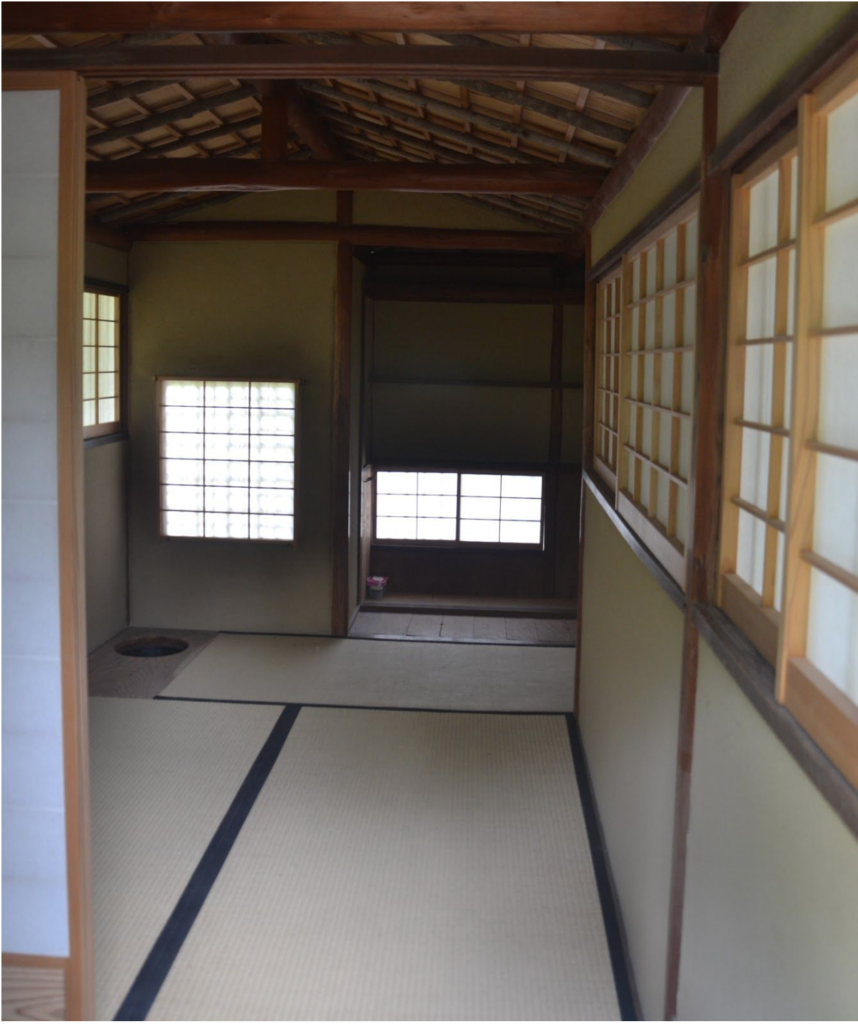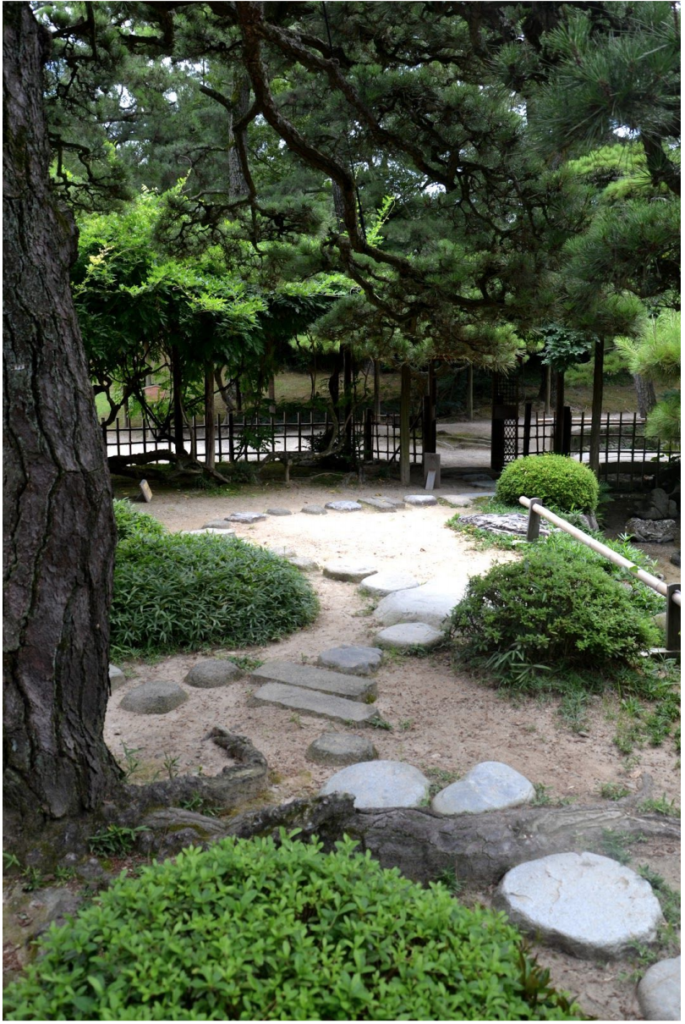The role of specific design elements of roji, (for example, tobi-ishi – the stone path which leads to a teahouse – has value as a tool for directing visuospatial attention), allow us to explore the restorative potential of ‘transitional’ spaces. We posit that such transitional spaces – that have long been present in Buddhist design – should be adapted within current design practices of contemporary spaces to focus on attention restoration.
Roji’s purpose is to serve as the surrounding for a teahouse; this surrounding is the space within which attention is restored and the mind is cleared. Roji is a type of garden on its own, but is usually located within larger gardens.
The origins and practice of the Japanese tea ceremony are essential in understanding how the ‘before’ or preparatory space of roji works.
As early as the 16th century, Japanese Tea Masters were shaping spaces to help people declutter their minds. By allowing for this offload to occur in the spaces that were both physically and metaphorically prior to the ceremony, guests could be fully present during the tea ceremony. Zen masters believe that forms such as everyday objects and design features can help ‘wake us up’, or positively distract us from normal thought patterns. The departure from routine presents opportunities to experience things that allow their suchness, or “nameless and characterless reality in its ultimate nature” become noticeable.1
Chanoyu is the traditional Japanese tea ceremony. Sen no Rikyu, a Tea Master from the 16th century is considered a father of wabi-cha, which is a ceremonial style focusing on such values like harmony, reverence, purity and tranquility.2 Wabi-cha is one of the most known styles of the ceremony, recognized also in popular culture via movies and stories. Tea ceremonies take place in a special garden pavilion, called chashitsu, surrounded by roji.
Rikyu writes about the roji in one of his poems:
While the roji is meant to be a passageway
Altogether outside this earthly life,
How is it that people only contrive,
To besprinkle it with dust of mind? 3
Purity in the tea ceremony is practiced in various ways. Including the literal: the regular sweeping of the premises and the presence of water in roji, but also metaphorically: in the mind and senses.
Various elements of the ceremony aim to cleanse the senses and bring clarity to the mind.4 One of the terms describing tea gatherings is “ichi-go, ichi-e,” or, “one time, one meeting.”5 Hence, the moment is unrepeatable; it requires utmost attention and full presence undisrupted by thoughts about any daily preoccupations.
Before entering the Tea House, guests walk through roji following the tobi-ishi which are “stepping stones” or “flying stones.” The stones are laid down in an asymmetrical manner, often following a zig-zag path.6


There are many variations in their arrangements and just as many explanations for the nature of the path. One story claims that a hermit named Dõtei introduced the path after seeing how the attendants of shogun spread various objects to cover the muddy path in front of them and protect their sandals from the dirt.7
In another variation, the origin of tobi-ishi was to protect the moss growing in the garden from being stepped on. With time, tobi-ishi inherited aesthetic values of wabi-sabi and became part of the design that focused on enhancing the experience of the guests. The path was often sinuous and irregular, which forced guests to walk slower and one by one. Most of the stepping stones were only large enough to place one foot on top of and the placement of stones surrounding the path directed the sight of guests within the garden.8
These aesthetic elements forced guests to become more attentive on the path in front and around them, making them less likely to get distracted by idle chatter. Our brain is not able to process a lot of information gathered by our senses, especially visual information, therefore we select what parts of space pay attention to.9 This is an example of Visuospatial Attention, which enables us to selectively attend to and process stimuli in a space.10,11
Attention, in general, is a very important component of our cognition; it acts as the ‘gatekeeper’ of our conscious experience. The neurocognitive framework of the attention system consists of separate but interacting brain networks that underlie functions such as alertness, information selection, and executive control.12
However, we have limited attentional and processing capabilities; our sensory input ‘selects’ the more relevant information to our immediate goals depending on the situational context. As a result, in-the-moment experiential perception or grounding is not a constant for most people, unless attention is trained. Furthermore, our ability to direct attention depletes relatively easily by.
It is no secret that the environment can have a supportive role in depleting or restoring attention. Unfortunately, in contemporary structures, it is often the negative. Contemporary buildings often have features detrimental to attention. For example, convention centers, or trade fairs with complex floor plans and repetitive design elements result in poor wayfinding. Unnecessary and fruitless decision making led by confusing design depletes our energy and as a result, we arrive at meetings already frustrated instead of mentally cleansed.
Kaplan’s Attention Restoration Theory (ART), offers an approach to understand the mechanism which underlies the depletion of directed attention.13,14 It’s based on the simple premise that directed attention might be more likely to recover if it is allowed to rest.15
According to ART, there are 4 characteristics of restorative environments: soft fascination, extent, compatibility, and the ‘sense of being away’.16 Some types of environments require minimal involvement of directed attention because they provide features which capture attention in a bottom-up fashion. Such bottom-up attention is so gentle it does not interfere with other thoughts. This is referred to as ‘soft fascination’. People often talk of having to get away or needing a change when they are overwhelmed by the accumulation of mental fatigue.17 Being-away refers to a change of scenery and/or daily routines which promotes a conceptual (and sometimes real) distance from the ordinary.18 Natural environments, such as parks, gardens, and lakefronts, are able to involuntarily capture attention, as are Roji.19
The restorative potential of environments has been discussed and studied in a variety of contexts: urban spaces20,21,22, healthcare settings23,24, museums25, monasteries26, gardens.27,28,29
However, we haven’t found any research on the restorative potential of transition spaces. We believe that such research and the implementation of the findings into design elements could be beneficial for the users of and in contemporary buildings such as offices, congress centres, universities, performance centres and many more.
A variety of methods can be used to assess directed attention and the restorative potential of transition spaces: simple neuropsychological computer based tasks or questionnaires, and advanced methods requiring advanced research tools and presence of trained staff. To mention a few:
- Basic Tests:
Neuropsychological:
- SART: Sustained Attention Response Task.30,31 SART is a computer-based task which can be used to measure working memory, sustained attention, and impulse/inhibitory control.32
- Necker Cube Pattern Control Test: The test is designed to measure one’s capacity to direct mental effort.33
Survey/ Questionnaire:
-
- Environmental Restorativeness can be measured to assess the restorative potential of both potential and existing spaces.34 ER can be assessed with the Perceived Restorativeness Scale, a survey/questionnaire with 16 items judged on a 7-point scale.35
- Advanced:
Neurophysiological:
- Dichotic listening tests and recordings of Event Related Potentials, (EEG),36,37
- Brainwave recordings in response to natural landscapes which stimulate the patterns of brain activity associated with positive emotional states characterized by ‘frontal alpha power asymmetry’. That is, lower alpha power on the left frontal lobe in comparison to the right.38,39
Physiological:
- Cortisol level when exposed to decreased cognitive loads, hence lower levels of stress expected.40
- Heart Rate Variability (HRV) to measure the parasympathetic nervous systems response to decreased stress levels and decreased cognitive load.41,42
In conclusion, spaces which are often regarded as “non-spaces” such as entries, corridors and passages can play an important role in improving the experience of the building as a whole by affording users the opportunity to engage or disengage at appropriate times. These spaces could be intentionally designed as restorative environments. We believe that even basic design interventions, such as the introduction of greenery, the implementation of intuitive wayfinding features, and comfortable sitting places or artworks can aid users to alter their thinking patterns and regain focus on the present. We would like to further investigate these hypotheses and use the above-mentioned methods to test the influence of Japanese roji and other nature-inspired elements in contemporary interiors.
References
1 Merriam-Webster Dictionary, online version
2 T. Izutsu. (1964). The Theory of Beauty in the Classical Aesthetics of Japan, A Record of Nanbo p.135-158
3 D.T. Suzuki. (1938). Zen and Japanese Culture, Zen and the Art of Tea I p.271-289
4 Tsunetomo, Yamamoto. (1716). Hagakure
5 Ii, Naosuke (1858). Chanoyu Ichie Shū
6 H.Dumoulin. (1988). Zen Buddhism: Japan
7 Ketchell, R. (1970). Stepping Stones in the Japanese Garden. Retrieved September 14, 2020, from https://robertketchell.blogspot.com/2014/06/stepping-stones-in-japanese-garden.html
8 N. Nonaka (2008) The art of setting stones. Site Lines. A Journal of Place
9 Nicolas et al. (2019). Inducing oculomotor plasticity to disclose the functional link between voluntary saccades and endogenous attention deployed perifoveally. Nature Scientific Reports
10 Posner and Petersen. (1990). The Attention System of the Human Brain. Annual Review Neuroscience
11 Cohen, Ronald. (2017). Directed attention. Encyclopedia of Neuropsychology
12 Jones et al. (2016). Measuring the Performance of Attention Networks with the Dalhousie Computerized Attention Battery (DalCAB): Methodology and Reliability in Healthy Adults. Front. Psychol.
13 Kaplan, S. (1995). The restorative benefits of nature: Toward an integrative framework. Journal of Environmental Psychology
14 Kaplan, S. (2001). Meditation, restoration, and the management of mental fatigue. Environment and Behavior
15 Ibid.
16 Kaplan, Stephen. (1992). The Restorative Environment: Nature and Human Experience. Relf, Diane (editor). 1992. The Role of Horticulture in Human Well-Being and Social Development. Portland, OR: Timber Press.
17 Ibid.
18 Scopelliti et al. (2019). Is it Really Nature That Restores People? A Comparison With Historical Sites With High Restorative Potential. Front. Psychol.
19 Ibid.
20 Karmanov, Dmitri & Hamel, Ronald. (2008). Assessing the restorative potential of contemporary urban environment(s): Beyond the nature versus urban dichotomy. Landscape and Urban Planning
21 Pazhouhanfar, Mahdieh & Kamal, Mustafa. (2014). Effect of predictors of visual preference as characteristics of urban natural landscapes in increasing perceived restorative potential. Urban Forestry & Urban Greening
22 Olszewska-Guizzo et al. (2020). Can Exposure to Certain Urban Green Spaces Trigger Frontal Alpha Asymmetry in the Brain?—Preliminary Findings from a Passive Task EEG Study. International Journal of Environmental Research and Public Health.
23 Abdelaal, Mohamed S. & Soebarto, Veronica. (2019). Biophilia and Salutogenesis as restorative design approaches in healthcare architecture. Architectural Science Review
24 Nejati et al. (2015). Restorative Design Features for Hospital Staff Break Areas: A Multi-Method Study. HERD: Health Environments Research & Design Journal
25 Kaplan et al. (1993). The Museum as a Restorative Environment. Environment and Behavior
26 Kaplan et al. (2005). The monastery as a restorative environment. Journal of Environmental Psychology
27 Betrabet, Gowri. (1996). The Garden as a Restorative Environment: A Theoretical Perspective. Journal of Therapeutic Horticulture, Vol. 8, Therapeutic Landscapes: Designing Gardens for Health and Healing
28 Hardwig et al. (2011). The Role of Botanic Gardens in the Science and Practice of Ecological Restoration. Conservation Biology
29 Heyd, Thomas. (2002). Nature Restoration Without Dissimulation Learning from Japanese Gardens and Earthworks. Environmental Aesthetics
30 Cassarino et al. (2019). Testing Attention Restoration in a Virtual Reality Driving Simulator. Front. Psychol.
31 Berto, R. (2005). Exposure to restorative environments helps restore attentional capacity. Journal of Environmental Psychology
32 Sustained Attention to Response Task. Science Of Behavior Change. Online
33 Cimprich et al. (1995). Views to nature: effects on attention. Journal of Environmental Psychology
34 Hartig et al. (1997). A Measure of restorative quality in environments. Scandinavian Housing and Planning Research
35 Ibid.
36 Bayazit et al. (2009). Dichotic listening revisited: trial-by-trial ERP analyses reveal intra- and interhemispheric differences. Neuropsychologia
37 Jerger et al. (2007). Divided-Attention and Directed-Attention Listening Modes in Children with Dichotic Deficits: An Event-Related Potential Study. Am Acad Audiol
38 Cooper et al. (2003). Paradox lost? Exploring the role of alpha oscillations during externally vs. internally directed attention and the implications for idling and inhibition hypotheses. International Journal of Psychophysiology
39 Olszewska-Guizzo AA, Paiva TO and Barbosa F (2018) Effects of 3D Contemplative Landscape Videos on Brain Activity in a Passive Exposure EEG Experiment. Front. Psychiatry
40 Tang et al. (2007). Short-term meditation training improves attention and self-regulation. Proceedings of the National Academy of Sciences
41 Forte et al. (2019). Heart Rate Variability and Cognitive Function: A Systematic Review. Front. Neurosci.
42 Elsadek et al. (2018). Cross-cultural comparison of physiological and psychological responses to different garden styles. Urban Forestry and amp; Urban Greening.











